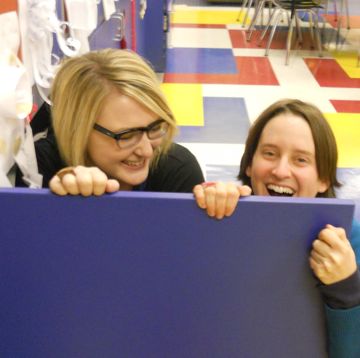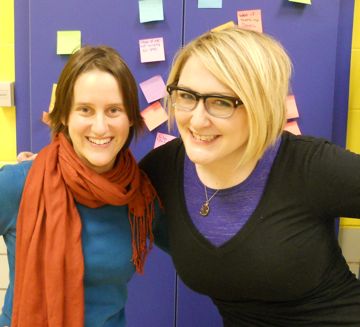This week I want to share a conversation that took place between myself and two of our current, amazing Art21 Educators…
Julia CopperSmith and Maureen Hergott teach elementary art education at Scott and Westdale Elementary Schools in Melrose Park and Northlake near Chicago. Their work has been inspiring to all of us here at Art21 so far this year, especially since they are finding ways to work with contemporary art and engage some very young students in the process. Since we will soon be accepting applications for year 4 of Art21 Educators, I am happy to post this interview which was just wrapped up last week. Enjoy!
Joe Fusaro: First, could you both talk about why you applied to be a part of the Art21 Educators program? Did one person convince the other? If so, how?
Julia CopperSmith: I learned about Art21 in college after watching an episode of Art in the 21st Century in an undergraduate studio foundations class. Art21 really impacted my thinking; I thought it was a really exciting program. I remained abreast of Art21’s programs, educational resources, and read Art21’s blog. I learned about Art21 Educators through the blog and immediately informed Maureen about it. Maureen and I had already been collaborating on lesson planning and attending other professional development activities together. We already had a great collaborative practice and parallel views about elementary art education. We were already focusing on teaching using contemporary methodologies and practices, and had both used Art21 artists and films in our lessons. So we thought this would be a perfect experience to participate in and hoped it would enrich our teaching practice.
Maureen Hergott: I remember being so excited and a little nervous when she first forwarded me the information. While we had participated in several local contemporary arts professional development activities, this whole Art21 thing seemed like so much more of a big deal! I had seen a few Art21 episodes throughout the years and really enjoyed them, but never used the many resources Art21 had to offer in my nine years teaching art. Julia and I decided right away that we would be thrilled to participate in the program, so we embarked on the daunting application process. I say “daunting” because, well… it IS daunting. Daunting yet do-able. Actually, the application process turned out to be quite a learning experience for both of us. We never really experimented at any length using iMovie, and we did just that to make our application videos. We basically started learning some of the skills that would be required of us throughout the year as soon as we began the application process.
JF: What were you hoping to get out of participating when you first applied?
JCS: We wanted to have more of a conversation about how to incorporate contemporary art and art making practices into the elementary classroom. We had been discussing this topic between ourselves, and we wanted an opportunity to have this discussion with other teachers as well. We were also excited to meet other educators and hear about what they were doing with their students. We liked the idea of being in a community of educators, and wanted to see how they successfully incorporate contemporary art into their curriculum.
MH: In many of the other professional development workshops we attended together, there was a strong focus on how to teach with contemporary art at the high school level. We felt (and still feel) that it was just as important to teach using contemporary art and art making practices with our elementary students. We wanted to further expand our knowledge of using contemporary art in our classrooms. We were also hoping to meet other art teachers with similar interests who wanted to teach in ways that might inspire our own teaching practice.
JF: Describe any kind of prep you did in order to “get ready” to come to NYC last July. How did that preparation assist with your experience?
JCS: We reviewed some of the Art21 artists and resources. We had many conversations about going to New York- we were curious about what we were going learn, who we were going to meet, and what we were going to do. We were very excited to go to New York and were up for any type of adventure.
MH: Julia and I were absolutely ecstatic when we found out we were going to get to participate in the Art21 Educators program. There wasn’t really very much prep work to do BEFORE we started participating. Most of the work happens AFTER the program begins! But, we did the required readings and answered the survey questions sent before arriving in NY. We took the time to look into the Art21 websites and familiarized ourselves with some of the Art21 artists.
JF: What did you enjoy most about the Art21Educator institute this past summer?
MH: It was wonderful to be able to spend a week with other educators who were so dedicated to the task of evolving their teaching practice. At times, the summer institute felt overwhelming, but knowing that we were all in it together, helping one another, and learning from each other—I had never experienced a professional support system like that.
JCS: The institute inspired me to structure my curriculum in a more connected and dynamic way. Creating a unit for Art21 Educators inspired Maureen and I to alter the form in which we planned our academic year. The institute also inspired me to think about how my students can participate in more in-depth discussions in class. It made me think extensively about the students’ art making processes and provide opportunities for students to make more thoughtful choices within their art making. Neither of us expected to reevaluate the way we structured our entire school year. It is very exciting for both of us to revisit past lessons and redesign them to create a more meaningful learning experience for our students.
JF: Could each of you describe an “a-ha” moment from the summer institute- a moment where you thought, “This is going to change the way I teach.”
MH: I did some serious reflection and re-evaluation of my past teaching practices before and during the summer institute. Most of my “a-ha” moments came when I began asking myself, “What have I really been teaching my students?” By designing “projects” that had clear end results, I noticed that I had essentially removed my students from the most important parts of the art-making process. I was making many of the artistic choices for them when they should be the ones to make those choices. This was not how I wanted to continue my teaching practice and that was a huge “a-ha” moment for me.
JCS: The introduction of video as a reflection and instructional tool was an “a-ha” moment for my teaching practice. When I incorporated documentation as a method for the students to gain perspective in their art making processes, the classroom became a more active learning environment. Allowing students to use cameras as they work as a means for reflection on their art making process has significantly changed the way that I teach. Being able to review how they created their work helps my students to think about why they make the choices they do in the classroom, as well as recall the experiences they had from week to week.
JF: How has that “a-ha” moment affected the year so far?
MH: Rather then designing “projects” for our students to make, Julia and I have been trying to develop lessons that allow our students to have contemporary art-making experiences. We try to give them the foundation and confidence to be able to explore a variety of materials and make artistic choices on their own. We want them to have a sense of pride in and ownership of their artwork. Often times, we have the students working collaboratively so that they can share ideas and learn from one another.
JCS: I see my students once a week. As an adult it is easy to forget that for an elementary school student a week is a long period of time. It has been helpful for my teaching to begin lessons by showing my students video clips from the prior week’s lesson. Using documentation as a starting point for discussion has assisted my students in building upon their prior learning experiences.
JF: What are you most proud of at this point in the school year?
MH: There have been so many moments when I look around the art room and each and every student is totally engaged in their artwork. They are not gossiping about other students and they are not talking about what they watched on TV last night. They are sharing ideas, problem solving, and helping each other experiment with the materials. They are actually being artists. Those are the moments when I am truly filled with a sense of pride.
JCS: I am proud of the evolution within my teaching practice. Being a part of Art21 Educators has made my collaboration with Maureen more cohesive. We are both dedicated to a continuous growth within our teaching practices. Teaching with fresh, contemporary methodologies and art making processes have fostered more lively and engaging lessons. We are teaching our students in an active manner that provides mores choices and opportunities for self-direction and conceptual development.
JF: As elementary art educators, which artists have been your favorite to work with so far?
JCS: Artists that I have incorporated in my curriculum so far have included Oliver Herring, Matthew Barney, Arturo Herrera, and Allan McCollum.
MH: And Julie Mehretu!
JF: And which season 6 artists are you looking forward to?
JCS: One of the artists I am looking forward to is SarahSze. I already have a lesson in progress that uses her work as a point of investigation for my students. In addition, my 4th graders this year have constructed projects dealing with the use of everyday objects in site-specific spaces. Introducing Sarah Sze’s work can help further expand upon that exploration.
I am also looking forward to viewing David Altmejd’s feature. I think my students will be interested in his large-scale anthropomorphic figures. The transformations within his sculptures and the supernatural aspects of his work will provoke some lively conversation.
Finally, I have always enjoyed Lynda Benglis’ use of materials in her practice- particularly, her bright latex floor pieces and her large-scale sculptures. I’m excited to see her interview in Season 6.
JF: Any words of wisdom for future Art21 Educator applicants?
MH: The Art21 Educators program is a yearlong endeavor. Be prepared to be refining and rethinking your teaching practices as well as actively participating on the Art21 Ning site throughout the year. Also, for those applying to the Art21 Educator program, I (we) highly recommend staying in the NYU dorms. After a long day of discussion and reflection, it’s really valuable to be able to come back to the dorms and continue the conversation in a more relaxed atmosphere.
JCS: I would tell future applicants to be open to the idea of expanding your teaching practice. There is great potential in learning from the other participants in the program. In addition, be prepared to document your teaching practice and share classroom experiences with the other members of the program. I am very thankful to be participating in the Art21 Educator Program!







Pingback: Teaching with Contemporary Art in the Elementary Classroom | Art21 Blog
Pingback: Talking with Art21 Educators: Jethro Gillespie and Jack Watson | Art21 Blog
Pingback: A Year of Contemporary Art in (and out of) Contemporary Classrooms | Art21 Blog
Pingback: Five Years of Teaching with Contemporary Art | Art21 Blog